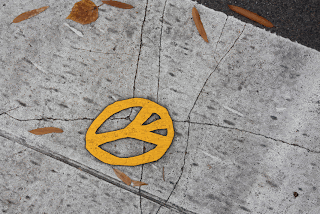 |
| The Toynbee Tiler's main style, in Philadelphia's Center City. |
While the film plays out as History Detectives for hipsters, the story is compelling. The tiles have a central, cryptic message that invoke historian Arnold Toynbee and filmmaker Stanley Kubrick:
“Toynbee idea
In Movie 2001
Resurrect Dead
On Planet Jupiter"
The Toynbee Tiler has been prolific, installing his pieces since the 1980s in the asphalt of urban streets from his home base in Philadelphia, across the Rust Belt, to South America. The tiles defy explanation, though they have the stylistic consistency of a single artist. While the basic message doesn’t vary, he adds, at times, addenda and marginalia that range from mentioning the USSR to critiquing the media.
While the film is fascinating on a variety of levels, one of its most poignant aspects is the way the filmmakers create a portrait of the unknown Tiler. Through interviews and by tracing clues scattered in the tiles, newspapers, and minutes of an esoteric organization, they suggest that the tiles were primarily a means of communicating a public message in a pre-Internet world. Today, the Toynbee Tiler would have an easier time writing a blog, but the film shows his attempts to use other methods to find an outlet and audience for his message, from ham radio transmissions to calling in to talk radio shows. These strategies were small and inconsequential, and he found himself blocked by corporate media control of the airwaves.
 |
| City street as faulty archive: remnants of a decaying tile. |
Of course, in the age of the Internet, interest in the tiles has only grown as scattered individuals who had seen a tile in their city became aware of their spread. Interestingly, contemporary art groups have incorporated the tiles into their own street art. House of Hades, one of the more prolific of these collectives, creates their own tiles that critique the media, adopting one of the Toynbee Tiler’s favorite themes while purging it of its more unsavory aspects. Such approaches preserve the formal qualities of the tiles while effacing much of the haunted affect inhering in the obsessive repetition and syntactical unhingement of the originals. Connected today with a street art culture derived from graffiti and expressed in ways that strategically repurpose public space (for example, in the images of artists like Banksy), the contemporary tilers’ method is necessarily different in meaning from the Toynbee Tiler.
 |
| Other artists adopt the tile technique for less ambiguous messages. |
Not only are the messages themselves quite different, they are now received by more jaded eyes. For instance, many people leaving a screening of Resurrect Dead in Philadelphia admitted that they first assumed the tiles were either a student art project or a viral marketing campaign. Changes in technology, meaning, and modes of dissemination since the 1980s have gutted the semiotic landscape in which the Toynbee Tiles first appeared, leaving us more knowing about these kinds of visual languages but also perhaps nostalgic for the more truly mysterious affect of the Tiler’s exhibits. While contemporary modes of cultural signification build off his techniques, they also make impossible this kind of unknowable world created by a singular vision.
~ Mary Rizzo and Whitney Strub
 |
| Easily missed at 9th and Walnut, this small tile's ambiguous message can be read as step one of an instructional series or a plaintive expression of solitude. |
(All photos are by Mary Rizzo and Whitney Strub.)






